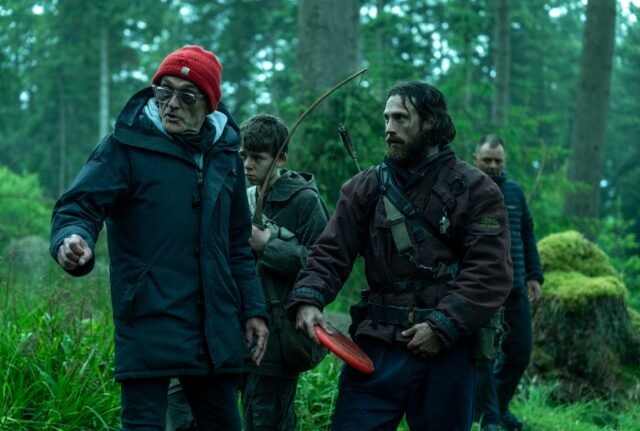28 Days Later offered a unique twist on a horror trope: Instead of the dead rising from their graves, the “zombies” in Danny Boyle’s zombie film would be normal humans transformed by the man-made “rage virus.” And they could run .
So after years and years of Boyle and writer Alex Garland debating whether to follow the maligned 28 Weeks Later with a proper sequel from the original team — and sorting out the complicated rights issues to do so — Boyle tells Polygon that there was actually a goal for what to do next.
“The idea of the film in many ways was to be as original as possible,” he says of This Week’s 28 Years Later. “Its structure is very unusual. Its progression is even more unusual, and it’s quite surprising, even at the script stage, to realize that the last third of the film is going to be this shifting examination of mortality in different ways — and it’s going to celebrate and commemorate that.”
28 Years Later tells the story of 12-year-old Spike (Alfie Williams) who has grown up on a walled island town off the coast of the quarantine zone. He has never seen the outside world; no one in the UK has been allowed to leave after the rabies virus decimated the population, and neighboring countries continue to patrol the perimeter to ensure normalcy for the outside world. Spike’s father, Jamie (Aaron Taylor-Johnson), believes it is essential for his son to grow up to be the toughest version of himself, a protector. At first, they venture into the wilderness to hunt, while Spike’s mother, Isla (Jodie Comer), suffers from a mysterious illness that no one in the microcosm is equipped to treat.
There is a strong human element to 28 years later — Boyle and Garland said Kes was a great inspiration, and the connection is deeply felt — but it manifests in more than just the survivors. Twenty-eight years after the first exposure to rabies, the infected have persisted, transformed and come closer to becoming a separate species.
“One of the things we’re doing is bridging the gap between humans and the infected,” Garland says. “We’re recognizing that they’re no different than us. They have a disease that a doctor would look at in a different way than the way we would instinctively react to it. So it’s a lot about things that seem very different but have more in common and can be approached or observed in different ways.”
Desde o início do desenvolvimento, Garland sabia que queria tirar proveito da grande passagem do tempo entre o primeiro filme e a nova sequência – 28 anos é um longo, muito tempo para uma sociedade em ruínas. E ao extrapolar a direção que o mundo poderia seguir, ele pousou em duas possibilidades que acabaram informando como os infectados que vemos em 28 anos depois evoluíram. “Uma é: não há mais infectada e a vida voltou ao normal. Então esse seria um tipo de filme que você poderia fazer, uma espécie de filme pós-COVID como era. E o outro é: não, a infecção ainda está viva. Bem, como ainda poderia ser vivo? Estes não são pessoas mortas reanimadas por meio de algum tipo de meios sobrenaturais. São pessoas que têm uma doença, uma condição ou vírus, neste caso. E então, como eles ainda estão vivos? Eles precisam consumir energia, precisam beber. ”
Os instintos de sobrevivência-e até a raiva que alimenta a caça interminável do infectada-existem em todo personagem 28 anos depoisestilo zumbi ou não. “Se você olhar para os filmes em detalhes, é algo que está dentro de todos nós”, diz Boyle. “Não existe a sensação de que é uma doença de fora ou algo assim, que há alguma doença que eles apenas têm e nós não. Todo personagem consegue exibir parte dela, o potencial para isso dentro de nós mesmos”.
Boyle e Garland não são os tipos de colocar um ponto tênue nos temas de seus próprios filmes, mas o escritor admite que há uma certa quantidade de frustração borbulhando sob a superfície de 28 anos depoise a maior idéia de que todo esse horror está acontecendo com pessoas reais de ambos os lados da linha.
“Eu acho que essas coisas são interpretativas, mas para mim seria sobre a maneira como nos últimos 10 a 15 anos, ficamos cada vez mais preocupados ao olhar para trás, em vez de olhar para frente, de volta à maneira como as coisas costumavam ser. Mas, em seguida, mais se selendo? É um filme sobre um estado agressivo e não um estado progressista, pelo menos em parte. ”
Fora do inferno do desenvolvimento que atormentou um proposto 28 meses depois veio não apenas 28 anos depoismas uma trilogia completa de filmes. A história parece completa com os créditos rolando 28 anospor design, mas nessa exploração de construção do mundo e comentários, Boyle e Garland descobriram claramente mais a dizer-e encontrará o caminho de volta ao filme original eventualmente.
“You have to acknowledge the first film, but at the very least, but we tried to make it a standalone film in its own right,” says Boyle. “But Cillian [Murphy, star of 28 Days Later ], for example, who would be the most obvious way to make it feel continuous with the first film, is a very important feature of the trilogy – but still not the only one.”
28 Years Later Opens in theaters June 20.


















